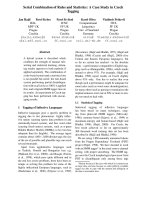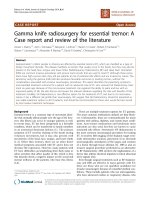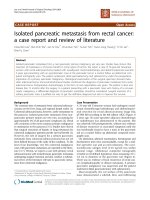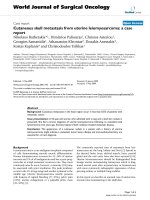báo cáo khoa học: "Lipid rescue of massive verapamil overdose: a case report" pdf
Bạn đang xem bản rút gọn của tài liệu. Xem và tải ngay bản đầy đủ của tài liệu tại đây (300.19 KB, 5 trang )
CAS E REP O R T Open Access
Lipid rescue of massive verapamil overdose: a
case report
Conrad W Liang
1
, Sarah J Diamond
2
and Daniel S Hagg
2*
Abstract
Introduction: Massive intentional verapamil overdose is a toxic ingestion which can cause multiorgan system
failure and has no currently known antidote.
Case Presentation: The patient is a 41-year-old Caucasian woman who ingested 19.2 g of sustained release
verapamil in a suicide attempt. Our patient became hypotensive requiring thr ee high-dose vasopressors to
maintain arterial pressure. She also developed acute respiratory failure, bradycardic ventricular rhythm necessitating
continuous transvenous pacing, and anuric renal failure. Our patient was treated with intravenous calcium,
bicarbonate, hyperinsulinemic euglycemi c therapy and continuous venovenous hemodialysis without success. On
the fourth day after hospital admission continuous intravenous lipid therapy was initiated. Within three hours of
beginning lipid therapy, our patient’s vasopress or requirement decreased by half. Within 24 hours, she was on
minimal vasopressor support and regained an underlying junctional rhythm. After three days of lipid infusion, she
no longer required inotropic agents to maintain blood pressure or pacing to maintain stable hemodynamics.
Conclusions: Intravenous fat emulsion therapy may be an effective antidote for massive verapamil toxicity.
Introduction
Calcium channel blockers are commonly prescribed for
hypertension and rate control of atrial fibrillation, but
can be highly toxic in large quantities. Massive overdose
of these medications is a serious clinical problem seen
rarely in the intensive care unit; management is typically
supportive, with variable rates of success [1-4]. Here, we
report the successful use of int ravenous lipid therapy to
reverse the systemic ef fects of severe verapamil toxicity
and we review the literature relating to this complex
problem.
Verapamil is a non-dihydropyridine calcium channel
blocker with greater cardioselectivity than diltiazem at
therapeutic levels. One review suggests that, on over-
dose, verapamil is more likely to depress atrioventricular
(AV) nodal conduction [1]. Peak plasma concentration
occurs in up to eight hours in sustained release verapa-
mil, while its half life ranges from two to eight hours
and its volume of distri bution is 250 to 400 L [5]. Toxic
effects common to all calci um channel blockers include
dysrhythmias, hypotension and bradycardia from depres-
sion of the sinoatrial node. Overdose is rare but fre-
quently lethal. In a 2007 annual report of poison
centers, calcium channel blockers accounted for only
12% of all cardiovascular drug exposures but 47% of
deaths due to cardiovascular drug poisoning [6].
Reported complications in clude bowel infarction , stroke,
hyperglycemia, and non-cardiogenic pulmonary edema
[2]. Massive verapamil overdose, defin ed here as inges-
tion of greater than 8 g, is almost uniformly fatal with
few case reports of survivors [7-9].
Until recen tly, there has b een no known ant idote.
Treatment is largely supportive with gastrointestinal
decontamination and inotropic support as needed to
maintain blood pressure [2,3]. Intravenous calcium infu-
sion is logically indicated to o vercome intracellular
hypocalcemia but the benefit in overdose is unclear and
may even be toxic [10]. Hyperinsulinemic euglycemia
(HIE) therapy and glucagon administration have been
suggested to imp rove cardiac inotropy and utilization of
glucose, with some success [2,11-13]. However, all of
these interventions act secondarily by supporting the
body while the drug is naturally eliminated, as opposed
to directly neutralizing the circulating drug. In contrast,
* Correspondence:
2
Department of Medicine, Oregon Health and Science University, 3181 SW
Sam Jackson Park Road, Portland, Oregon, 97201 USA
Full list of author information is available at the end of the article
Liang et al . Journal of Medical Case Reports 2011, 5:399
/>JOURNAL OF MEDICAL
CASE REPORTS
© 2011 Liang et al; licensee Bi oMed Central Ltd. This is an Open A ccess article distributed under the terms of the Creative Commons
Attribution Lice nse (http://c reativecommons.org/licenses/by/2.0), which permits unrestricted use, distribution, and reproduction in
any medium, provided the original work is properly cited.
lipid infusions are thought to sequester lipophilic drugs
like verapamil thus, in theory, directly decreasing their
bioavailability in the body [14,15].
We present a case of a single-drug, massiv e verapamil
overdose in a failed suicide attempt that was refractory
to standard resuscitation techniques, I V calcium and
bicarbonate, HIE therapy and continuous venovenous
hemodialysis (CVVH), but rapidly responded to intrave-
nous lipid infusion.
Case Presentation
A 41-year-old Caucasian woman with a history of
depression presented to the emergency department (ED)
of a referring hospital shortly after taking 80 tablets of
sustained release verapamil 240 mg (19.2 g). At the ED,
she was treated with multiple doses of activated char-
coal, fluids and calcium, and was subsequently trans-
ferred to our intensive care unit six hours post-
ingestion. Her vital signs on admission were normal (see
Table 1 for timeline of our patient’s clinical decline and
recovery). An initial e xam was unremarkable; our
patient was easily aroused, alert and oriented, and
appeared well. Serum chemistry, complete bloo d count
and liver functi on tests were normal except for a mildly
elevated serum calcium of 10.8 mg/dL and a hematocrit
of 36.5%. A urine drug screen was negative, and aceta-
minophen and salicylate levels were undetectable. Her
initial electrocardio gram (ECG) at the referring ED
showed n ormal sinus rhythm, left ventricular hypertro-
phy, and poor R wave progression. At the time of trans-
fer, the ECG reveale d sinus bradycardia and inverted T
waves in the anterior precordial leads. Telemetry moni-
toring demonstrated occasional premature ventricular
contraction s and apparent U waves. The Oregon Poison
Center was consulted at this time, and no specific anti-
dotes were initiated given the patient’s clinical appear-
ance. In particular, whole bowel irrigation was not
recommended.
Eight hours after admission, at 14 hours post-inges-
tion, our patient’s systolic blood pressure dropped to
80-90 mmHg and her heart rate to 50-60 beats per min-
ute (bpm). An ECG showed third degree AV block.
Clinically, our patient became lethargic, her oxygen
saturation dropped while on a nasal cannula and she
was placed on a 100% non-rebreather. Rapid calcium
administration, fluids and dopamine were given with no
Table 1 Timeline of the patient’s clinical course through the administration of lipids
Time Temp Pulse Rhythm BP Vent Epi Norepi Vaso
Admit
(Day 1)
36.7 59 SB 115/73 99% 2L NC 0 0 0
+8 hrs 56 Junctional 85/50 91% 6L NC 0 0 0
Abrupt clinical decline; intubation necessitated; bradycardia requiring transvenous pacer; vasopressors, furosemide, hydrocortisone, antibiotics,
calcium, insulin and glucagon infusions begun
+24 hrs
(Day 2)
38.5 100 Paced 97/60 SIMV
FiO2 80%
0.02 0.3 0.04
Hypercoagulable requiring heparin infusion; bicarbonate infusion for acidosis; oliguric with renal failure requiring continuous venovenous
hemodialysis (CVVH)
+48 hrs
(Day 3)
38.2 70 Paced 90/49 SIMV
FiO2 85%
0 0.418 0.05
Worsening respiratory status requiring airway pressure release ventilation (APRV); anuric and pacer dependent
+72 hrs
(Day 4)
38.4 70 Paced 124/72 APRV
FiO2 80%
0.04 0.75 0.05
Intravenous lipid infusion started
+76 hrs 37.5 70 Paced 149/63 APRV
FiO2 90%
0.04 0.75 0.05
+80 hrs 37.2 70 Paced 128/72 APRV
FiO2 50%
0.04 0.3 0.04
+96 hrs
(Day 5)
36.8 70 Paced 134/88 APRV
FiO2 50%
0.03 0.1 0.04
+120 hrs
(Day 6)
37.2 70 Paced 106/58 APRV
FiO2 50%
0.01 0.05 0
Improving respiratory status; APRV, CVVH, lipids, HIE, calcium, bicarbonate, and pacing stopped
+144 hrs
(Day 7)
37.6 67 Junctional 101/54 Vol A/C
FiO2 65%
0 0.03 0
Time measured as hours post-admission, which was six hours post-ingestion. Temperature recorded in Celsius. Rhythm SB: sinus bradycardia; Blood pressure (BP)
measured by cuff or arterial line if available; Vent NC: nasal cannula on liters of oxygen; SIMV: synchronized intermittent mandatory ventilation with fraction of
inspired oxygen (FiO2); APRV: airway pressure release ventilation with FiO2; Epi: epinephrine in μg/kg/min; Norepi: norepinephrine in μg/kg/min; Vaso:
vasopressin in units/min.
Liang et al . Journal of Medical Case Reports 2011, 5:399
/>Page 2 of 5
response; isoproterenol produced a small increase in
heart rate. A ce ntral venous catheter was place d, and
norepinephrine and epinephrine infusion s were started.
Despite these interventio ns, our patient’s clinical condi-
tion continued to worsen. She underwent endotracheal
intubation and a temporary transveno us pacemaker was
placed to maintain her heart rate. HIE therapy was
initiated with 10% dextrose and insulin infusions, with
the i nsulin initially dosed at 40 units/hr with no bolus.
Glucagon infusion was started at this time as well.
Empiric vancomycin and piperacillin/tazobactam were
added due to leukocytosis of 17,400/mm
3
. Calcium
chloride infusion was cont inued throughout this time to
maintain an elevated ionized calcium level.
By the next morning, our patient’s blood pressure had
been stabilized with norepinephrine, epinephrine and
vasopressin infusions, and he r pulse was maintained by
transvenous pacing. Insulin infusion was briefly
increased to 60 units/hr before settling at 30 units/hr.
She developed simultaneous anion and non-anion gap
metabolic acidoses and was started on a bicarbonate
infusion. Her chest X-ray and physical exam were con-
sistent with significant volume overload from her multi-
ple infusions and resuscitation, and a furosemide
infusion was started. Her central venous pressure at this
time ranged from 22 to 46 mmHg. On hospital day
three, she developed a thrombosis of her right radial
artery at the site of an arterial catheter and was started
on intravenous heparin. Her previous urine culture grew
> 100,000 colonies of Staphyloccoccus with a white
count climbing to 31,700/mm
3
and fever to 40°C; broad
spectrum antibiotics were continued. Our patient subse-
quently developed refractory hypoxemia and was
switched to airway pressure release ventilation (APRV)
with supplemental nitric oxide and cisatracurium, with
improvement in her oxygenation. She developed anuric
renal failure and was started on CVVH. As a result of
the initial resuscitation and these interventions, she
received a total of 40.7 L of fluid. Despite these thera-
pies, our patient’s condition continued to decline. At the
nadir of her clinical course, she had no underlying heart
rhythm without pacemaker support and required 0.75
μg/kg/hr of norepinephrine, 0.04 μg/kg /hr of epinephr-
ine, and 0.05 units/min of vasopressin to maintain a
perfusing mean arterial pressure.
A literature review suggested the use of lipid t herapy
as a possible antidote, and on hospital day four our
patient was started on an intralipid infusion with a 100
ml bolus of 20% followed by continuous infusion at 0.5
ml/kg/hr. Three hours after the infusion was started, the
norepinephrine dose was decreased by more than 50%
to 0.3 μg/kg/hr. After a further 48 hours, vasopressin
had been stopped and her vasopressor requirement had
dropped to 0.01 μg/kg/hr of epinephrin e and 0.05 μg/
kg/hr of nor epinephrine. On hospital day six, our
patient regained a junctional heart rhythm with a hea rt
rate o f 65-70 bpm and transvenous pacing was discon-
tinued. Her re spiratory status had also improved signifi-
cantly enough to stop APRV, nitric oxide and
cisatracurium. On day seven, she was weaned off vaso-
pressors and changed to pressure support ventilation.
Her renal function improved, urine output increased,
and CVVH was discontinued. At this point, it was felt
that she had overcome the acute effects of verapamil
overdose, and her calcium, HIE therapy and intravenous
lipids were discontinued. Her blood pressure normalized
and her heart rhythm was sinus tachycardia with a rate
into the 110s. A total of 4,200 mL of intralipid was
administered over the initial seven days in the intensive
care unit.
Our patient’s recovery was comp licated by leukocyto-
sis and tachycardia that persisted even after her blood
pressure and renal failure had improved. She had a dis-
tended abdomen, but was able to communicate and f ol-
low simple commands while intubated and did not
complain of significant abdominal discomfort . A com-
puted tomography scan of her abdomen revealed pneu-
matosis intestinalis, and our patient underwent a same-
day, urgent subtotal colectomy and colostomy for
ischemic colitis. She slowly improved and was dis-
charged from t he intensive care unit on 33 days after
ingesting t he tablets. She was discharged from the hos-
pital on post-ingestion day 55 to a skilled nursing facil-
ity. At discharge she was alert and oriented with intact
verbal function, was able to walk with standby assis-
tance, and was eager to be discharged. At the time of
publication she has completed extensive physical rehabi-
litation and will soon be returning home to be with her
family.
Discussion
Over the past decade, intravenous fat emulsion therapy
has gained credibility as an antidote for local anesthetic
toxicity [16]. It has been a true be nch-to-bedside story,
emerging from the theory of sequestering lipophilic
drugs to successful animal trials and human case reports
[17-21]. Focus is now turning to the use of lipid emul-
sions as successful antidotes for other lipophilic drugs,
such as verapamil, beta blockers, and tricyclic antide-
pressants. Most of th ese studies have been performed in
animal models, and case reports are now appearing to
validate the laboratory findings [16]. Despite the lack of
large trials, the anecdotal successes are compelling and
the indications and limitatio ns for lipid th erapy are now
being explored [22-24].
Several studies have demonstrated the efficacy o f fat
emulsion therapy in verapamil overdose in animals
[14,15,25]. The initial study by Tebbutt et al. showed a
Liang et al . Journal of Medical Case Reports 2011, 5:399
/>Page 3 of 5
dramatic effect, with lipid therapy nearly doubling the
time to death, the mean lethal dose and the median
lethal dose (LD50) of rodents being infused with verapa-
mil, as compared with saline [14]. Bania et al. then
demonstrated in a canine model that lipid infusion com-
bined with standard resuscitation techniques led to
increased survival, characterized by increased mean
arterial press ures detectable within 30 minutes of start-
ing the lipid infusion. At 60 minutes, there was a signifi-
cant improvement in maximal ventricular pressure, and
an observed but non-significant improvement in heart
rate, cardiac output, and systemic vascular resistance. At
120 minutes, the survival percentage of animals receiv-
ing lipid therapy was 100%, compared to 14% survival of
controls receiving saline [25]. A follow-up study in
rodents showed that the greatest survival benefit with
bolus dosing occurred at 18.6 ml/kg, while the greatest
benefit to heart rate, mean arterial pressure, and base
excess occurred at 24.8 ml/kg. These doses are higher
than the recommended maximal daily dose of 10 ml/kg/
day used for artificial parenteral nutrition in humans,
which suggests t hat high dosing may be necessary to
reverse severe drug toxicity [15].
Three recent cases illustrate the potential of lipid ther-
apy in calcium channel blocker overdose. Young et al. pre-
sent a case of multidrug overdose including 13.44 g of
verapamil in combination with bupropion, zolpidem, que-
tiapine, clonazepam and benazepril [26]. Their patient pre-
sented to the hospital hypotensive and acidotic, requiring
mechanical ventilation and norepinephrine to maintain
arterial pressure. Lipid therapy was initiated almost imme-
diately upon arrival, and within an hour the norepinephr-
ine dose was halved. The patient was extubated on day
two, and di scharged on day five with no neurologic defi-
cits. Montiel et al. describe a second case of a patient who
ingested 3.6 g of sustained-release diltiazem who was trea-
ted with hyperinsulinemic euglycemia therapy in combina-
tion with lipid therapy [27]. Their patient had an
improvement in blood pressure within one hour of begin-
ning intravenous lipid, and was discharged from the inten-
sive care unit on day nine with a full recovery. Finally,
French et al. report a case of sustained verapamil overdose
treated with lipid emulsion therapy. Notably, the serum
level of verapamil in their case was slightly decreased after
administration of lipids [28].
This is the second report of intralipid fat emulsion
therapy being used in verapamil overdose, both in c on-
junction with high dose insulin and having a benefit
after HIE has failed. Significantly, intralipid fat emul sion
therapy was given for a longer period than in prior
reports, and in response to a much larger overdose of
verapamil. Our case demonst rates that lipid therapy can
be effective in a pure, massive overdose of sustained-
release verapamil, a nd that this efficacy can manifest
several days after ingestion. Our patient was initially
managed conserv atively with standard resuscitation
techniques and care was escalate d as her clinical condi-
tion declined; lipid therapy was started as it became
clear that she was worsening despite our best treatment.
Although a causal relationship between lipid therapy
and clinical i mprovement cannot be definitiv ely deter-
mined, the time course of her recovery is compelling.
Within hours of starting t he lipid therapy, her disease
course abruptly reversed, and within days she had
regained an intrinsic heart rhythm and no l onger
required pacing or vasopress ors. In retrospect, her need
for additional therapies, including transvenous pacing,
high-dose vasopressors and/or inotropes, HIE therapy,
bicarbonate infusion, broad spectrum antibiotics and
continuous hemodialysis, may have been lessened if
lipid therapy had been started earlier.
The optimal dose, timing, and duration of therapy
remain unclear. Animal studies of lipid infusion with
verapamil toxicity have used primarily single bolus dos-
ing, while case reports commonly include an initial
bolus plus continuous infusion. Our initial dosing was
based on previous case reports [26], and the duration of
therapy was determined by our patient’ sclinical
improvement. In general, however, intravenous fat emul-
sions have been given safely and routinely to critically ill
patients as parenteral nutrition. Adverse effects in t he
acute period include allergic reaction and the potential
to develop fat or pulmonary emboli. Patients requiring
long-term use may also develop liver dysfunction.
Conclusion
Intravenous lipid therapy is a plausible and effective
therapy for massive calcium channel blocker overdose,
and could be considered early in patients presenting
with hemodynamic compromise.
Consent
Written informed consent was obtained from the patient
for publicatio n of this case report and any accompany-
ing d ata. A copy of the written consent is available for
review by the Editor-in-Chief of this journal.
Acknowledgements
This work was supported by the Division of Pulmonary and Critical Care
Medicine.
Author details
1
Department of Neurology, Oregon Health and Science University, 3181 SW
Sam Jackson Park Road, Portland, Oregon, 97201, USA.
2
Department of
Medicine, Oregon Health and Science University, 3181 SW Sam Jackson Park
Road, Portland, Oregon, 97201 USA.
Authors’ contributions
CL performed a chart review and literature search. All authors read and
approved the manuscript.
Liang et al . Journal of Medical Case Reports 2011, 5:399
/>Page 4 of 5
Competing interests
The authors declare that they have no competing interests.
Received: 9 January 2011 Accepted: 20 August 2011
Published: 20 August 2011
References
1. Ramoska EA, Spiller HA, Winter M, Borys D: A one-year evaluation of
calcium channel blocker overdoses: toxicity and treatment. Ann Emerg
Med 1993, 22:196-200.
2. Newton CR, Delgado JH, Gomez HF: Calcium and beta receptor
antagonist overdose: a review and update of pharmacological principles
and management. Semin Respir Crit Care Med 2002, 23:19-25.
3. Zimmerman JL: Poisonings and overdoses in the intensive care unit:
general and specific management issues. Crit Care Med 2003,
31:2794-2801.
4. DeWitt CR, Waksman JC: Pharmacology, pathophysiology and
management of calcium channel blocker and beta-blocker toxicity.
Toxicol Rev 2004, 23:223-238.
5. McTavish D, Sorkin EM: Verapamil. An updated review of its
pharmacodynamic and pharmacokinetic properties, and therapeutic use
in hypertension. Drugs 1989, 38:19-76.
6. Bronstein AC, Spyker DA, Cantilena LR Jr, Green JL, Rumack BH, Heard SE:
2007 Annual Report of the American Association of Poison Control
Centers’ National Poison Data System (NPDS): 25th Annual Report. Clin
Toxicol (Phila) 2008, 46:927-1057.
7. Hofer CA, Smith JK, Tenholder MF: Verapamil intoxication: a literature
review of overdoses and discussion of therapeutic options. Am J Med
1993, 95:431-438.
8. Ashraf M, Chaudhary K, Nelson J, Thompson W: Massive overdose of
sustained-release verapamil: a case report and review of literature. Am J
Med Sci 1995, 310:258-263.
9. Johansen KK, Belhage B: [A 48-year-old woman’s survival from a massive
verapamil overdose]. Ugeskr Laeger 2007, 169:4074-4075.
10. Sim MT, Stevenson FT: A fatal case of iatrogenic hypercalcemia after
calcium channel blocker overdose. J Med Toxicol 2008, 4:25-29.
11. Nickson CP, Little M: Early use of high-dose insulin euglycaemic therapy
for verapamil toxicity. Med J Aust 2009, 191:350-352.
12. Patel NP, Pugh ME, Goldberg S, Eiger G: Hyperinsulinemic euglycemia
therapy for verapamil poisoning: case report. Am J Crit Care 2007, 16:520,
518-519.
13. Verbrugge LB, van Wezel HB: Pathophysiology of verapamil overdose:
new insights in the role of insulin. J Cardiothorac Vasc Anesth 2007,
21:406-409.
14. Tebbutt S, Harvey M, Nicholson T, Cave G: Intralipid prolongs survival in a
rat model of verapamil toxicity. Acad Emerg Med
2006, 13:134-139.
15. Perez E, Bania TC, Medlej K, Chu J: Determining the optimal dose of
intravenous fat emulsion for the treatment of severe verapamil toxicity
in a rodent model. Acad Emerg Med 2008, 15:1284-1289.
16. Cave G, Harvey M: Intravenous lipid emulsion as antidote beyond local
anesthetic toxicity: a systematic review. Acad Emerg Med 2009,
16:815-824.
17. Weinberg GL, VadeBoncouer T, Ramaraju GA, Garcia-Amaro MF, Cwik MJ:
Pretreatment or resuscitation with a lipid infusion shifts the dose-
response to bupivacaine-induced asystole in rats. Anesthesiology 1998,
88:1071-1075.
18. Weinberg G: Lipid rescue resuscitation from local anaesthetic cardiac
toxicity. Toxicol Rev 2006, 25:139-145.
19. Rosenblatt MA, Abel M, Fischer GW, Itzkovich CJ, Eisenkraft JB: Successful
use of a 20% lipid emulsion to resuscitate a patient after a presumed
bupivacaine-related cardiac arrest. Anesthesiology 2006, 105:217-218.
20. Litz RJ, Popp M, Stehr SN, Koch T: Successful resuscitation of a patient
with ropivacaine-induced asystole after axillary plexus block using lipid
infusion. Anaesthesia 2006, 61:800-801.
21. Sirianni AJ, Osterhoudt KC, Calello DP, Muller AA, Waterhouse MR,
Goodkin MB, Weinberg GL, Henretig FM: Use of lipid emulsion in the
resuscitation of a patient with prolonged cardiovascular collapse after
overdose of bupropion and lamotrigine. Ann Emerg Med 2008, 51:412-415.
22. Brent J: Poisoned patients are different-sometimes fat is a good thing.
Crit Care Med 2009, 37:1157-1158.
23. Picard J, Harrop-Griffiths W: Lipid emulsion to treat drug overdose: past,
present and future. Anaesthesia 2009, 64:119-121.
24. Cave G, Harvey M: Lipid emulsion as antidotal therapy-ready to register?
Crit Care Med 2009, 37:2325-2326.
25. Bania TC, Chu J, Perez E, Su M, Hahn IH: Hemodynamic effects of
intravenous fat emulsion in an animal model of severe verapamil
toxicity resuscitated with atropine, calcium, and saline. Acad Emerg Med
2007, 14:105-111.
26. Young AC, Velez LI, Kleinschmidt KC: Intravenous fat emulsion therapy for
intentional sustained-release verapamil overdose. Resuscitation 2009,
80:591-593.
27. Montiel V, Gougnard T, Hantson P: Diltiazem poisoning treated with
hyperinsulinemic euglycemia therapy and intravenous lipid emulsion.
Eur J Emerg Med 2011, 18:121-123.
28. French D, Armenian P, Ruan W, Wong A, Drasner K, Olson KR, Wu AH:
Serum verapamil concentrations before and after Intralipid® therapy
during treatment of an overdose. Clin Toxicol (Phila) 2011, 49:340-344.
doi:10.1186/1752-1947-5-399
Cite this article as: Liang et al.: Lipid rescue of massive verapamil
overdose: a case report. Journal of Medical Case Reports 2011 5:399.
Submit your next manuscript to BioMed Central
and take full advantage of:
• Convenient online submission
• Thorough peer review
• No space constraints or color figure charges
• Immediate publication on acceptance
• Inclusion in PubMed, CAS, Scopus and Google Scholar
• Research which is freely available for redistribution
Submit your manuscript at
www.biomedcentral.com/submit
Liang et al . Journal of Medical Case Reports 2011, 5:399
/>Page 5 of 5









